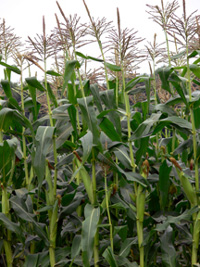 |
| Photo: Mike Parr |
Background
Biomass refers to
living and recently living biological material that can
be used as fuel. Most commonly, biomass refers to plant
matter grown for use as biofuel (such as corn for ethanol),
but also includes plant or animal matter used for production
of fibers, chemicals, or heat.
Biomass power (excluding ethanol) is close to a carbon-neutral
electric power generation option — biomass absorbs
carbon dioxide from the atmosphere during its growth and
then emits an equal amount of carbon dioxide when it is
processed to generate electricity. Thus, biomass fuels simply
"recycle" atmospheric carbon without adding to
global warming impacts.
Biomass in the
U.S.
Because biomass power
is produced from plant sources, it can potentially be produced
almost anywhere in the United States.
Impacts on Birds
The biggest environmental
problems with biomass, particularly corn ethanol, is the
large amount of land required to harvest energy which otherwise
could be used for other purposes or left as undeveloped
land.
Similarly, converting land for bioenergy production also
results in the loss of high value bird habitats such as
wetlands, wet meadows, extensively managed semi-natural
grassland and scrub. A good example can be found in the
ongoing debate of the reauthorization of the Farm
Bill, which includes the proposed conversion of land
in the Conservation Reserve Program (CRP) into corn ethanol
production. Since its inception in 1986, CRP has converted
millions of acres of cropland to grass cover across the
prairies, and to grass or forest cover in the Southeast.
CRP removes eroding cropland from cultivation and protects
it with perennial vegetation for 10-15 year contracts. Bird
populations have been shown to utilize CRP, including the
American Tree Sparrow, Northern Bobwhite, Dark-eyed Junco,
American Goldfinch, Horned Lark, Lapland Longspur, and Eastern
and Western Meadowlarks - with some studies reporting increases
in reproductive rates and population gains attributable
to CRP.
Another problem is that crops grown for biofuels are the
most land and water-intensive of the "renewable" energy sources.
In 2005, about 12% of the nation’s corn crop
(covering 11 million acres of farmland) was used to produce
four billion gallons of ethanol, which equates to about
2% of annual U.S. gasoline consumption. For biofuels
to make a much larger contribution to the energy economy,
the industry will have to accelerate the development of
new feed stocks, agricultural practices, and technologies
that are more land and water efficient.
Corn-derived ethanol, in particular, is not as environmentally
friendly as its advocates would like us to believe. Ethanol
produces less carbon monoxide than gasoline, but it produces
just as much nitrous oxides. In addition, ethanol
adds aldehydes and alcohol to the atmosphere, all of which
are carcinogenic. When all air pollutants associated with
the entire ethanol system is measured, ethanol production
is found to contribute to major air pollution problems.
Conclusion/Solutions
Biomass is a
renewable energy resource and can have positive environmental impacts by reducing emissions
and pollutants. However, factory farming of biomass crops can
reduce biodiversity and negatively impact bird habitat.
For example, tracts of un-tilled native prairie are tremendously
important to grassland birds; they support many species
that rarely if ever use cropland or even CRP fields, such
as Burrowing Owl, Sprague’s Pipit, Baird’s Sparrow,
and Chestnut-collared Longspur. Co-firing cellulosic biomass
with coal to make electricity is more effective for reducing
carbon dioxide emissions to the atmosphere than using it
to make ethanol.
The current administration
and many in Congress are pushing for a five-fold increase
in biofuels production. Biomass sourcing, therefore, should
be directed toward agricultural lands and forest plantations
already used or cleared for planting, and avoid our imperiled
wetlands, native forests, grasslands, and habitat for threatened
and endangered species.
